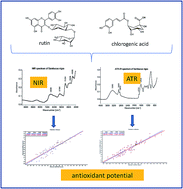Comparison of near-infrared diffuse reflectance (NIR) and attenuated-total-reflectance mid-infrared (ATR-IR) spectroscopic determination of the antioxidant capacity of Sambuci flos with classic wet chemical methods (assays)†
Abstract
Near-infrared diffuse reflectance (NIR) and attenuated-total-reflectance mid-infrared (ATR-IR) spectroscopy techniques in hyphenation with multivariate analysis were utilized to determine the antioxidant capacity of ground Sambuci flos samples. Folin–Ciocalteu (FC), ferric ion reducing antioxidant power (FRAP), cupric reducing antioxidant capacity (CUPRAC), 2,2-diphenyl-picrylhydrazyl (DPPH) and 2,2′-azino-bis-(3-ethylbenzothiazoline-6-sulfonic acid) diammonium salt (ABTS) were optimized and performed as reference methods. To remove systematic errors several spectral pretreatments like 1st and 2nd derivative Savitzky–Golay, standard normal variate (SNV) or multiplicative scatter correction (MSC) were applied. Cross-validations and test-set validations were performed for all assays. The quality parameters, standard error of prediction (SEP) and the ratio performance deviation (RPD), were calculated. An acceptable quality of the calibration can be confirmed for ATR-IR spectroscopy (e.g. for the CUPRAC assay: R2: 0.85, RPDcorr: 2.68, SECV: 0.13% GAE for cross-validation; R2: 0.81, RPDcorr: 2.20, SEP: 0.15% GAE for test-set validation). Surprisingly all models calculated for NIR spectroscopy were of poor quality and point to unpredictability of the antioxidative capacity. Further investigations of extracts by high performance liquid chromatography (HPLC) with a diode array detector (DAD) coupled to mass spectroscopy (MS) were performed to analyze the principal compounds. Thus, rutin and chlorogenic acid were confirmed to be the main components in the samples. This study demonstrates that ATR-IR spectroscopy is suitable to determine the antioxidative capacity in ground Sambuci flos samples and can be used for quality control.


 Please wait while we load your content...
Please wait while we load your content...